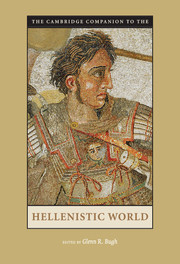Book contents
- Frontmatter
- Introduction
- 1 Alexander the Great and the Creation of the Hellenistic Age
- 2 The Hellenistic Kingdoms
- 3 The Polis and Federalism
- 4 Hellenistic Economies
- 5 The Hellenistic Family
- 6 History and Rhetoric
- 7 Material Culture
- 8 Hellenistic Art: Two Dozen Innovations
- 9 Language and Literature
- 10 Greek Religion: Continuity and Change in the Hellenistic Period
- 11 Philosophy for Life
- 12 Science, Medicine, and Technology
- 13 Hellenistic Military Developments
- 14 Greeks and Non-Greeks
- 15 Recent Trends and New Directions
- Hellenistic Dynasties
- Works Cited
- Index
7 - Material Culture
Published online by Cambridge University Press: 28 November 2007
- Frontmatter
- Introduction
- 1 Alexander the Great and the Creation of the Hellenistic Age
- 2 The Hellenistic Kingdoms
- 3 The Polis and Federalism
- 4 Hellenistic Economies
- 5 The Hellenistic Family
- 6 History and Rhetoric
- 7 Material Culture
- 8 Hellenistic Art: Two Dozen Innovations
- 9 Language and Literature
- 10 Greek Religion: Continuity and Change in the Hellenistic Period
- 11 Philosophy for Life
- 12 Science, Medicine, and Technology
- 13 Hellenistic Military Developments
- 14 Greeks and Non-Greeks
- 15 Recent Trends and New Directions
- Hellenistic Dynasties
- Works Cited
- Index
Summary
It’s not what you find, it’s what you find out.
Thomas (1979) 30Alexander the Great’s favorite sculptor, Lysippos, was a versatile craftsman: He created both the bronze portraits that Alexander so favored and a new form of ceramic vessel (either a drinking cup or a transport amphora) for King Kassandros (Athenaios 11.784c). Both of these seemingly disparate items fall within the catch-all category of material culture, succinctly defined by one authority as “that sector of our physical environment that we modify through culturally determined behavior.” This definition embraces both art and artifacts, but also much more: domestic breeds of plants and animals, the flattened skull that results from the use of the cradle board, even, Deetz has argued, the spoken word (the arrangement of air molecules by the oral cavity to produce culturally determined sounds). The role material culture played in the past and its consequence for present-day knowledge of the ancient world cannot be overestimated, even in the realm of the most intellectual of that world’s achievements. The stylus Aristotle used to write the Metaphysics, the papyrus or writing tablet on which he wrote, the chair or stool he sat on, and the table at which he sat were all pieces of material culture; and without yet more material culture - manuscripts copied and recopied through the ages - we would know nothing about it.
- Type
- Chapter
- Information
- The Cambridge Companion to the Hellenistic World , pp. 136 - 157Publisher: Cambridge University PressPrint publication year: 2006
- 8
- Cited by

